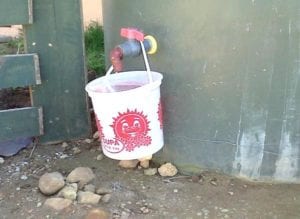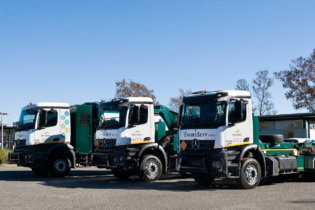Water collected in rainwater harvesting tanks provided in a low-cost housing project in Kleinmond, Western Cape, does not meet the standards for drinking water, unless treated, according to the findings of a Water Research Commission (WRC) study.
As demand for water grows in South Africa, alternative sources are actively being sought to augment conventional water supply. While domestic rainwater harvesting has been put forward as one such an alternative water supply, little information is available on whether harvested rainwater is safe for human use or even how local communities feel about using the water from such an alternative source. Domestic rainwater harvesting involves the collection and storage of water from rooftops and diverse surfaces. A team of researchers from the Stellenbosch University (SU) Department of Microbiology and the Department of Sociology and Social Anthropology studied the quality of water from a community with rainwater harvesting tanks, and gathered information on how this water is being used. The project was funded by the Water Research Commission. The study site selected was the Kleinmond Housing Scheme. This innovative low-cost housing project, conceptualised in 2007 in collaboration between the Department of Science & Technology, CSIR, the Western Cape Provincial Department of Human Settlements and the Overstrand Local Municipality, comprises 410 housing units. Various technology innovations have been applied in the houses, including modular masonry material, reinforced ring beams, prefabricated plumbing etc., and each house equipped with a 2 000 l rainwater harvesting tank. The SU team tested the chemical and microbial quality of rainwater collected from the rainwater tanks of 29 houses over six months. In addition, 68 households were interviewed to investigate the acceptance and perception on the use of the domestic rainwater harvesting tanks. The results obtained for the chemical analysis indicated that the rainwater quality was within potable, chemical standards. Metals, cations and anions that were analysed for in the harvested rainwater samples were all below the recommended drinking water guidelines. However, the microbial analysis showed that the presence of the following group of indicator organisms exceeded the recommended drinking water guidelines: total coliforms, Eneterocci, faecal coliforms, and heterotrophic bacteria. The presence of several opportunistic pathogens, including E.coli, Cryptosporidium and Salmonella, were also detected. In short, the water from the rainwater harvesting tanks in Kleinmond is not fit for human consumption, and prior treatment is required before the water source can be used for drinking purposes. The main causes of contamination are dirt and faeces (from birds and small animals) on the roof surface, which fall into the tank. Other sources of rainwater contamination include leaf debris and organic material washed into the tank, animals or birds that fall into uncovered tanks as well as breeding mosquitoes. It was found that many of the households placed their garbage bags on top of the tanks to protect them from being ripped open by stray dogs. These garbage bags could easily contaminate the rainwater, especially if the tanks are leaking or broken and/or the lid is absent. This general lack of awareness of contamination hazards highlights the importance of training users in the proper use and maintenance of the technology.It has been recommended that some form of pre-treatment be installed to make the rainwater safe for drinking. As a follow up to this part of the project, the SU team is now investigating the use of solar water pasteurisation and filtration systems for the treatment of harvested rainwater.
Interestingly, the SU user survey indicated that the majority of community members of the Kleinmond Housing Scheme instinctively steered clear of using the water from their rainwater harvesting tanks for drinking purposes. About two-thirds of the respondents do not use the water in the tank for drinking, while by far the majority of those who use it for drinking do so only sometimes (24%). The majority of respondents who do drink the water pre-treat it first. One mother reported that her baby developed a rash after rainwater was used to bath him, while others said that drinking the water was ‘bad for your stomach’. The majority of respondents indicated that they use the harvested rainwater for household chores instead, such as laundry, cleaning, and gardening. One respondent was even applying his rainwater to help run his small car wash business. While not generally using the harvesting rainwater for drinking purposes, almost all users (bar one respondents) saw the tank as being of huge benefit to them, particularly as they now used less municipal water, which put money back into their pockets. In addition, the tanks became a convenient asset during times of municipal water disruption. According to the WRC Research Manager Dr Nonhlanhla Kalebaila, rainwater tanks are not a ‘fit-and-forget’ technology, and require regular maintenance and upkeep. Unfortunately, most tank users at Kleinmond admitted that they did not know how to maintain their tanks although they did indicate a willingness to learn. Thankfully at the time of data collection, the majority of rainwater tanks were found to be in good condition, with only some tanks showing signs of leakage, missing lids, broken pipes or taps. Most of these faults had been reported to the municipality, which, according to the SU project team, indicates some hesitancy to take ownership of the tanks. A training programme has been recommended to empower users in the proper use and maintenance of the tanks. “Users need to ensure that their tanks are covered to prevent mosquito breeding, and sunlight from reaching water which promotes algal growth”, further explains Dr Kalebaila. “However, through the incorporation of cartridge filters or other treatments at the point of consumption can ensure better quality of drinking-water and reduces health risks”. Materials used in the catchment and storage tank should be suitable for use and be non-toxic to humans. Storages should be fitted with a mechanism such as a tap or outlet pipe that enables hygienic abstraction of water.








